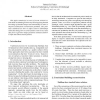82
Voted
3DIM
2003
IEEE
15 years 6 months ago
2003
IEEE
This paper addresses a registration refinement problem and presents an accurate and fast Point-to-(Tangent) Plane technique. Point-to-Plane approach is known to be very accurate ...
96
Voted
3DIM
2003
IEEE
15 years 6 months ago
2003
IEEE
Recently, various technologies have become available for scanning real-world objects, enabling rapid and accurate shape acquisition. In most cases, such solutions have high cost, ...
3DIM
2003
IEEE
15 years 6 months ago
2003
IEEE
Highly realistic virtual human models are rapidly becoming commonplace in computer graphics. These models, often represented by complex shape and requiring labor-intensive process...
116
click to vote
3DIM
2003
IEEE
15 years 6 months ago
2003
IEEE
Autonomous range acquisition for 3D modeling requires reliable range registration, for both the precise localization of the sensor and combining the data from multiple scans for v...
105
Voted
3DIM
2003
IEEE
15 years 6 months ago
2003
IEEE
Due to their general and robust formulation deformable models offer a very appealing approach to 3D image segmentation. However there is a trade-off between model genericity, mode...
87
Voted
3DIM
2003
IEEE
15 years 6 months ago
2003
IEEE
This paper summarizes a series of recent research results made at Edinburgh University based applying domain knowledge of standard shapes and relationships to solve or improve arc...
3DIM
2003
IEEE
15 years 6 months ago
2003
IEEE
Motivated by the requirements of the present archaeology, we are developing an automated system for archaeological classification and reconstruction of ceramics. Due to the natur...
3DIM
2003
IEEE
15 years 6 months ago
2003
IEEE
This paper proposes and evaluates the use of a mirror for improving the scanning process when using laser-stripe acquisition devices. We propose to exploit mirrors for two differe...
3DIM
2003
IEEE
15 years 6 months ago
2003
IEEE
We present a case study of scanning 3D objects for the purposes of education and public information. We begin by describing the original design of a 3D scanning system now in use ...
115
click to vote
3DIM
2003
IEEE
15 years 6 months ago
2003
IEEE
In this paper, we present a new approach to high quality 3D object reconstruction. Starting from a calibrated sequence of color images, the algorithm is able to reconstruct both t...

